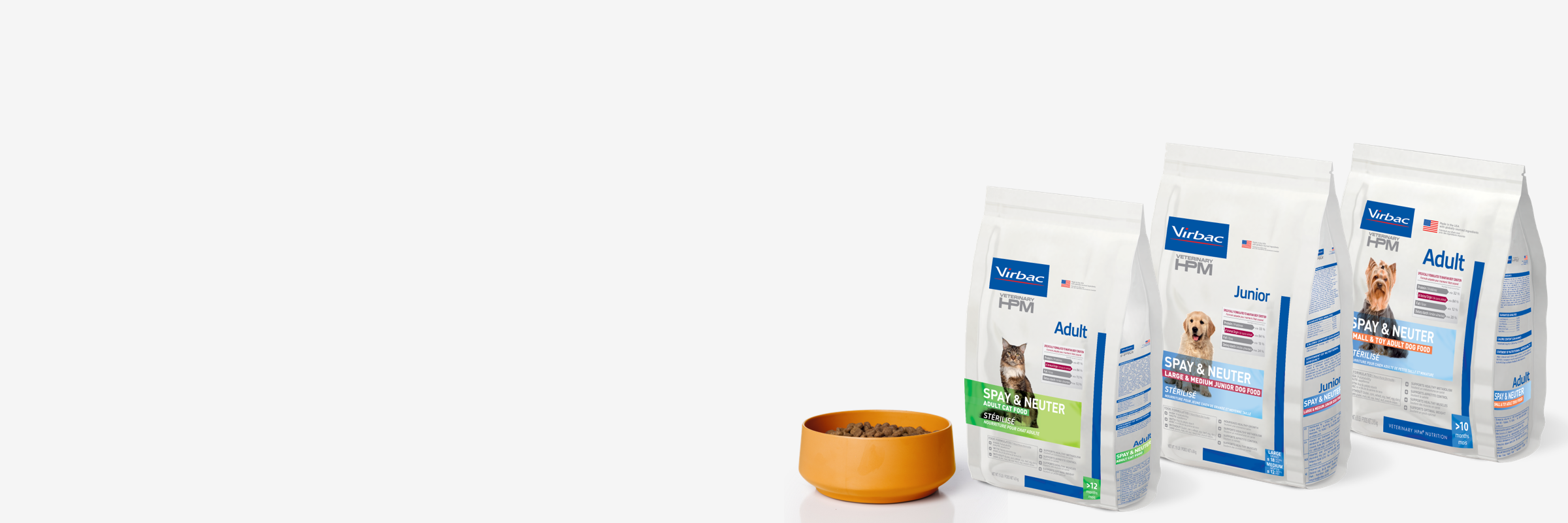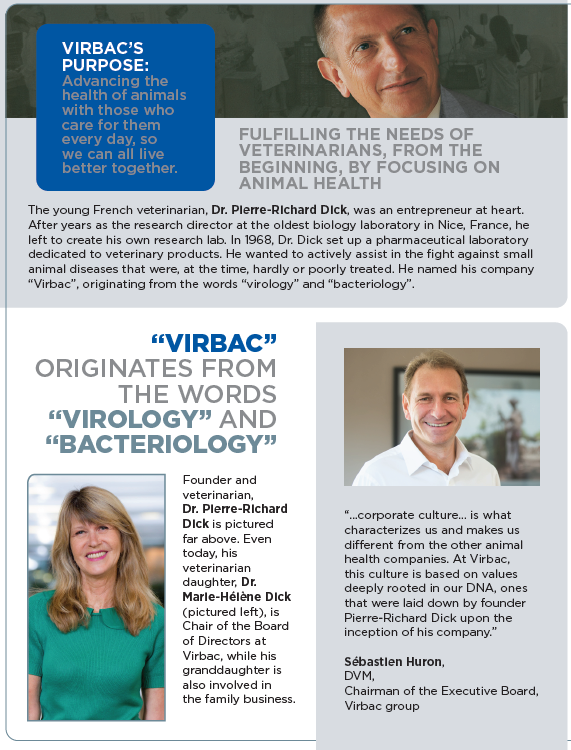
Why Virbac Pet Food?
PURPOSEFUL NUTRITION THROUGH VETERINARIANS
We’re proud to be the first animal health company to launch our own pet food formulation in Canada and exclusively for veterinarians. The range of Virbac VETERINARY HPM® Spay & Neuter Diets for dogs and cats offers an approach which is different from that of other food product ranges in the veterinary market. The major innovation of this new product range is that its aim is to respect spayed and neutered dogs’ and cats’ need for the nutrients available from animal protein. All our foods are formulated so that proteins represent the major source of energy, with the proportion of carbohydrates being as limited as possible.

Nutrition Designed for Spayed and Neutered Pets
The number of spayed and neutered pets in Canada continues to climb. It has become essential to develop a food that meets the specific needs of these pets' bodies. Our expertise in animal health and pet food, combined with veterinarians' trust in our work, have enabled us to produce VETERINARY HPM® Spay & Neuter Diets for dogs and cats.




1. Canadian Animal Health Institute, 2020 Canadian Pet Ownership Study – Final Report. Kynetec December 17, 2020.
2. Banfield Pet Hospital: “Cats and dogs might have gained the “Covid 15” but new data reveals a pet obesity epidemic existed long before quarantine” June 21,
2021. Accessed: August 25 2023 https://www.banfield.com/about-banfield/newsroom/press-releases/2021/new-data-reveals-pet-obesity-epidemic-existed-longbefore-
quarantine
3. Association for Pet Obesity Prevention, State of U.S. Pet Obesity 2022 Accessed Sept. 23, 2023. https://www.petobesityprevention.org/2022#:~:text=59%25%20
of%20evaluated%20dogs%20were,increase%20from%2019%25%20in%202018.
4. Gross KL, Yamka RM, Khoo C, et al. Macronutrients. In: Hand MS, Thatcher CD, Remillard RL, et al., eds. Small Animal Clinical Nutrition. 5th ed. Mark Morris
Institute; 2010:49-105.
5. Berrazaga I, Micard V, Gueugneau M, Walrand S. The role of the anabolic properties of plant- versus animal-based protein sources in supporting muscle mass
maintenance: a critical review. Nutrients. 2019; 11(8):1825.
6. Donadelli RA, Aldrich CG, Jones CK, Beyer RS. The amino acid composition and protein quality of various egg, poultry meal by-products, and vegetable proteins
used in the production of dog and cat diets. Poult Sci. 2019; 98(3):1371-1378.
7. Bednar GE, Murray SM, Patil AR, Flickinger EA, Merchen NR, Fahey GC Jr. Selected animal and plant protein sources affect nutrient digestibility and fecal
characteristics of ileally cannulated dogs. Arch Tierernahr. 2000; 53(2):127-40.
8. Gerstein DE, Woodward-Lopez G, Evans AE, Kelsey K, Drewnowski A. Clarifying concepts about macronutrients’ effects on satiation and satiety. J Am Diet
Assoc. 2004 Jul; 104(7):1151-3.
9. Martin LJ, Siliart B, Lutz TA, Biourge V, Nguyen P, Dumon HJ. Postprandial response of plasma insulin, amylin and acylated ghrelin to various test meals in lean
and obese cats. Br J Nutr. 2010 Jun; 103(11):1610-9.
10. Vester BM et al. In utero and postnatal exposure to a high protein or high carbohydrate diet leads to differences in adipose tissue mRNA expression and blood
metabolites in kittens. Br J Nutr 2009; 102:1136-1144.
11. Backus RC. Management of satiety. Waltham Focus 2006; 16: 27-32.
12. Halton TL et al. The effects of high protein diets on thermogenesis, satiety and weight loss: a critical review. J Am College Nutr 2004; 23(5): 373-385.
13. Oberbauer AM, Larsen JA. Amino acids in dog nutrition and health. In: Wu G, ed. Amino Acids in Nutrition and Health: Amino Acids in the Nutrition of
Companion, Zoo and Farm Animals. Cham, Switzerland: Springer International Publishing; 2021:199-216.
14. Hoenig M et al. Insulin sensitivity, fat distribution, and adipocytokine response to different diets in lean and obese cats before and after weight loss. Am J
Physiol Regul Integr Comp Physiol 2007; 292: R227-R234.
15. Wei A et al. Influence of a high-protein diet on energy balance in obese cats allowed ad libitum access to food. J Anim Physio Anim Nutr 2011; 95: 359-367.
16. Vasconcellos RS et al. Protein intake during weight loss influences the energy required for weight loss and maintenance in cats. J Nutr 2009; 139: 855-860.
17. Kanchuk ML, Backus RC, Calvert CC, Morris JG, Rogers QR. Neutering induces changes in food intake, body weight, plasma insulin and leptin concentrations in
normal and lipoprotein lipase-deficient male cats. J Nutr. 2002 Jun; 132(6 Suppl 2):1730S-2S.
18. Kanchuk ML, Backus RC, Calvert CC, Morris JG, Rogers QR. Weight gain in gonadectomized normal and lipoprotein lipase-deficient male domestic cats results
from increased food intake and not decreased energy expenditure. J Nutr. 2003 Jun; 133(6):1866-74.
19. Cline MG, Burns KM, Coe JB, et al. 2021 AAHA Nutrition and Weight Management Guidelines for Dogs and Cats. J Am Anim Hosp Assoc. 2021; 57(4):153-178.
20. Lefebvre SL, Yang M, Wang M, Elliott DA, Buff PR, Lund EM. Effect of age at gonadectomy on the probability of dogs becoming overweight. J Am Vet Med
Assoc. 2013 Jul 15; 243(2):236-43.
21. Nguyen PG, Dumon HJ, Siliart BS, Martin LJ, Sergheraert R, Biourge VC. Effects of dietary fat and energy on body weight and composition after gonadectomy
in cats. Am J Vet Res. 2004 Dec; 65(12):1708-13.
22. Jeusette I, Detilleux J, Cuvelier C, Istasse L, Diez M. Ad libitum feeding following ovariectomy in female Beagle dogs: effect on maintenance energy requirement
and on blood metabolites. J Anim Physiol Anim Nutr (Berl). 2004 Apr; 88(3-4):117-21.
23. Jeusette I, Daminet S, Nguyen P, Shibata H, Saito M, Honjoh T, Istasse L, Diez M. Effect of ovariectomy and ad libitum feeding on body composition, thyroid
status, ghrelin and leptin plasma concentrations in female dogs. J Anim Physiol Anim Nutr (Berl). 2006 Feb; 90(1-2):12-8.
14. Hoenig M et al. Insulin sensitivity, fat distribution, and adipocytokine response to different diets in lean and obese cats before and after weight loss. Am J
Physiol Regul Integr Comp Physiol 2007; 292: R227-R234.
15. Wei A et al. Influence of a high-protein diet on energy balance in obese cats allowed ad libitum access to food. J Anim Physio Anim Nutr 2011; 95: 359-367.
16. Vasconcellos RS et al. Protein intake during weight loss influences the energy required for weight loss and maintenance in cats. J Nutr 2009; 139: 855-860.
17. Kanchuk ML, Backus RC, Calvert CC, Morris JG, Rogers QR. Neutering induces changes in food intake, body weight, plasma insulin and leptin concentrations in
normal and lipoprotein lipase-deficient male cats. J Nutr. 2002 Jun; 132(6 Suppl 2):1730S-2S.
18. Kanchuk ML, Backus RC, Calvert CC, Morris JG, Rogers QR. Weight gain in gonadectomized normal and lipoprotein lipase-deficient male domestic cats results
from increased food intake and not decreased energy expenditure. J Nutr. 2003 Jun; 133(6):1866-74.
19. Cline MG, Burns KM, Coe JB, et al. 2021 AAHA Nutrition and Weight Management Guidelines for Dogs and Cats. J Am Anim Hosp Assoc. 2021; 57(4):153-178.



